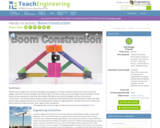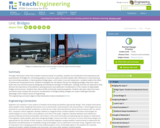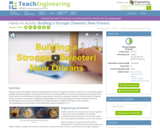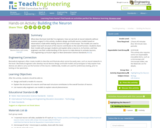
Informational, illustrated site covers the basics of cell structures and various cell types.

Informational, illustrated site covers the basics of cell structures and various cell types.

Tutorial on DNA basics that goes along with an online quiz over the material. Use the naviagation buttons at the bottom of the page to go to the quiz over the material.

A great site for understanding Amino Acids, the building blocks for protein. Besides a very complete summary, the site includes a complete list of amino acids, a link to basic amino acid structure, a list if atoms in amino acids, and links to test yourself. Very informative!

This ZOOM video segment shows how to create a self-contained environment and explores evaporation, condensation, and precipitation.

This review of what makes up human blood is easy to read and understand. There are guides to pronunciation and glossary links as well as a self quiz to check your understanding.

Student teams design their own booms (bridges) and engage in a friendly competition with other teams to test their designs. Each team strives to design a boom that is light, can hold a certain amount of weight, and is affordable to build. Teams are also assessed on how close their design estimations are to the final weight and cost of their boom "construction." This activity teaches students how to simplify the math behind the risk and estimation process that takes place at every engineering firm prior to the bidding phase when an engineering firm calculates how much money it will take to build the project and then "bids" against other competitors.

Through a five-lesson series that includes numerous hands-on activities, students are introduced to the importance and pervasiveness of bridges for connecting people to resources, places and other people, with references to many historical and current-day examples. In learning about bridge types arch, beam, truss and suspension students explore the effect of tensile and compressive forces. Students investigate the calculations that go into designing bridges; they learn about loads and cross-sectional areas by designing and testing the strength of model piers. Geology and soils are explored as they discover the importance of foundations, bearing pressure and settlement considerations in the creation of dependable bridges and structures. Students learn about brittle and ductile material properties. Students also learn about the many cost factors that comprise the economic considerations of bridge building. Bridges are unique challenges that take advantage of the creative nature of engineering.

In this video segment from PEEP and the Big Wide World, children make a dam with dirt, sticks, and stones to try to stop the flow of water.

Students create and analyze composite materials with the intent of using the materials to construct a structure with optimal strength and minimal density. The composite materials are made of puffed rice cereal, marshmallows and chocolate chips. Student teams vary the concentrations of the three components to create their composite materials. They determine the material density and test its compressive strength by placing weights on it and measuring how much the material compresses. Students graph stress vs. strain and determine Young's modulus to analyze the strength of their materials.

What does the brain look like? As engineers, how can we look at neural networks without invasive surgery? In this activity, students design and build neuron models based on observations made while viewing neurons through a microscope. The models are used to explain how each structure of the neuron contributes to the overall function. Students share their models with younger students and explain what a neuron is, its function, and how engineers use their understanding of the neuron to make devices to activate neurons.

Students are introduced to some basic civil engineering concepts in an exciting and interactive manner. Bridges and skyscrapers, the two most visible structures designed by civil engineers, are discussed in depth, including the design principles behind them. To help students visualize in three dimensions, one hands-on activity presents three-dimensional coordinate systems and gives students practice finding and describing points in space. After learning about skyscrapers, tower design principles and how materials absorb different types of forces, students compete to build their own newspaper towers to meet specific design criteria.The unit concludes with student groups using balsa wood and glue to design and build tower structures to withstand vertical and lateral forces.

In this media-rich lesson, students explore careers in science through profiles of Alaska Native scientists. They consider how traditional ways of knowing and Western approaches to science can complement each other and allow students to incorporate their own interests when considering careers in science.

This article provides links to six web sites that provide an overview of cause/effect relationships, graphic organizers, and teaching strategies for elementary teachers.

This interactive resource adapted from the National Park Service presents the key concepts of cave and karst systems, including how and where they form, different types, and various cave environments.

In this interactive activity adapted from the University of Nebraska, learn how and where transcription and translation occur within a cell and observe both processes in detail.

This pathway provides an introduction to cells as the basic unit of life and their structure and function. Prokaryotic, eukaryotic and plant cells are compared and the structure and function of different organelles is discussed. For a deeper look at this topic, we recommend the pathway Cell Structure from the OpenStax textbook Biology for AP® Courses.

This pathway provides an introduction to cellular mechanisms of transport, including a comparison of passive and active mechanisms. For a deeper look at this topic, we recommend the pathway Structure and Function of Plasma Membranes from the OpenStax textbook Biology for AP® Courses.

In this video adapted from the Arctic Athabaskan Council, learn how warmer temperatures in the Arctic are transforming the landscape, triggering a host of effects such as permafrost thawing and insect infestations.

As part of the General Chemistry Virtual Textbook, this site examines a variety of topics related to the Earth. This page looks at the Earth and its lithosphere, the chemical composition of the Earth, the structure of the Earth, and more.

This site provides a detailed overview of atoms. Content explores an atom's structure, as well as what ions are, how atoms bond, what compounds are (including how to name compounds), and what isotopes are.